The use of Long-term Care Technology and ICT equipment by Sasazu-en
In April 2024, the nursing care reimbursement system was revised, and the Productivity Improvements Promotion System Additions (I) (II) were newly established to encourage the use of technology, including Long-term Care Technology and ICT equipment. There are great expectations for the introduction of Long-term Care Technology and the use of ICT in the nursing care industry, which is facing a labor shortage. However, in order to receive the additional fees, facilities are required to "Establish a committee to ensure the safety of users and the quality of services, and to reduce the burden on staff" and to "Submit data on the results of operational improvements." As of June 2024, the acquisition rate of the additional fees (preliminary figures) was only 4.0% for Addition (I) and 21.1% for Addition (II) in special nursing homes.*1
Under such circumstances, Social Welfare Service Corporation Ohsawano Fukushi-Kai Special Nursing Home Sasazu-en (hereinafter, Sasazu-en), located in the southern part of Toyama Prefecture, has been actively promoting digital transformation and the use of ICT since the past and has obtained Addition (I). What effects will the introduction of ICT and Long-term Care Technology have on the nursing care industry? We interviewed Mr. Hiroyuki Iwai, the President of Sasazu-en, about its specific initiatives, changes in care settings due to the introduction of ICT, and operational improvements.
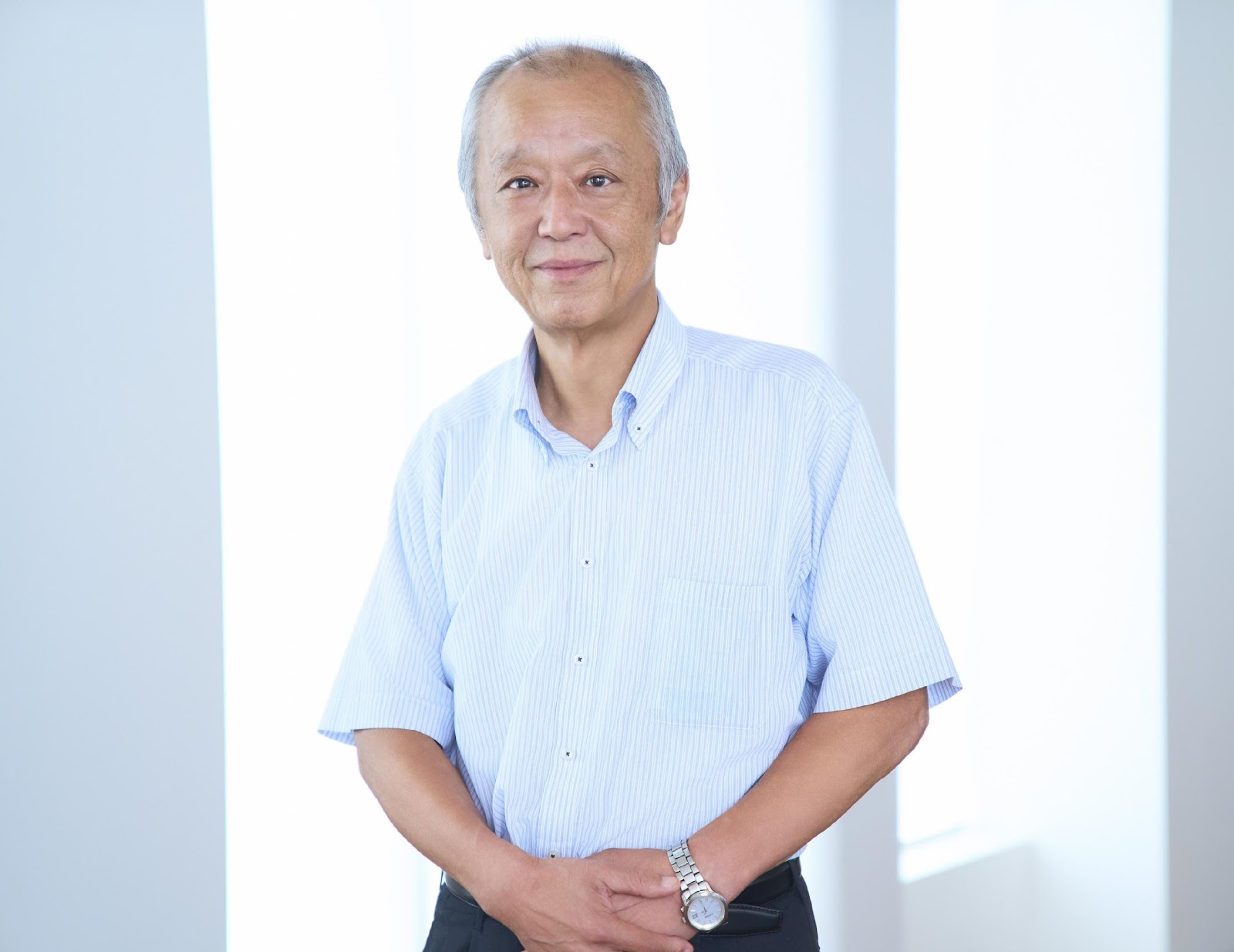
(Photo: Mr. Hiroyuki Iwai, the President of Sasazu-en)
The introduction of Long-term Care Technology and ICT equipment started as a measure to prevent back pain among care workers
- The declining workforce has become a social issue, and the labor shortage is a critical issue in the nursing care industry as well. Especially since Sasazu-en is located in a mountainous area with a small population, we heard that there were times in the past when it was difficult for you to recruit staff. Did you work on digital transformation and the introduction of ICT to resolve these issues?
President Hiroyuki Iwai (hereinafter, the same) "We were not promoting digital transformation from the start, but our initial motivation was to improve the problem of back pain that frequently occurred among our staff. Since there were many cases of absences on the day itself and resignations due to back pain, we thought that we needed to invest in equipment to prevent back pain among our staff in order to ensure we secured sufficient personnel, and around 2010, we began considering the use of transfer lifts and Long-term Care Technology. In 2012, we installed five transfer lifts, although they are not considered Long-term Care Technology."
- What was the first step in digital transforming your operations?
"In 2010, we prepared our internal LAN system and started using groupware to improve internal communication. By using an online system for notifications from the facility director to the entire staff, for communication among staff, and for the circulation of meeting minutes and conference records, which were previously conducted through documents and verbal communication, staff became able to access the latest and most accurate information at any time, thereby enabling efficient information sharing."
- So, you proceeded with the introduction of Long-term Care Technology and digital transformation at the same time?
"Yes. We felt that the use of ICT and digital transformation had the potential to improve the problems of staff members other than back pain, and we began working in earnest to promote digital transformation and the use of ICT in 2019 in order to provide safer and more efficient nursing care services. In 2021, our facility was adopted as a model project facility for the introduction of ICT by the Japanese Council of Senior Citizens Welfare Service. The accumulation of these measures naturally led to us fulfilling requirement (I) for the Productivity Improvements Promotion System Addition."
Reducing workload with transfer robots, monitoring systems, and work scheduling software
- Please tell us about the use of Long-term Care Technology and ICT equipment that you have currently introduced. First, please talk about Hug, the transfer support robot.
"We began to introduce Hug, which supports transfers from a sitting position for people who have difficulty standing up by themselves from a wheelchair to a bed or toilet, in 2019, and we are currently using 6 units.
In the past, transfer support was hard work requiring the assistance of two care workers, and it could only be provided by limited staff members depending on the physical size of the resident. With the use of Hug, we can now make smooth transfers with the support of only one staff member, regardless of the difference in the physical sizes of staff members and residents."
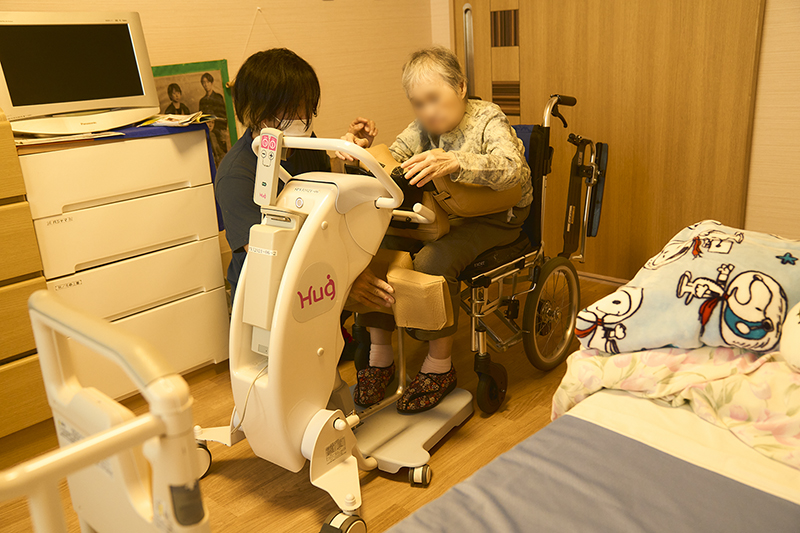
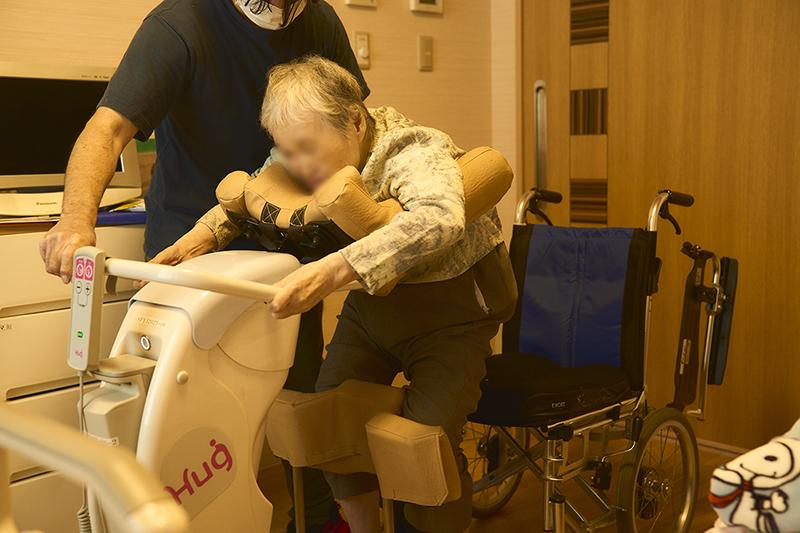
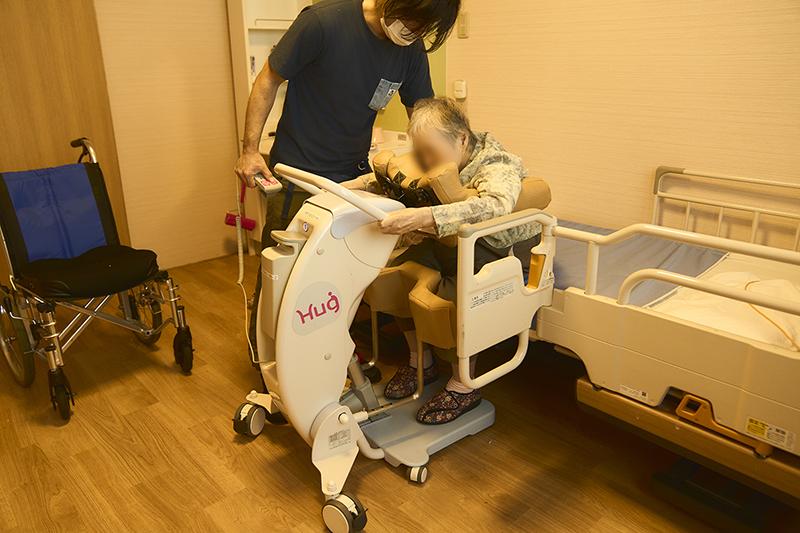
(Hug is used for transfers and moving from a wheelchair to a bed or toilet. As the name suggests, when the user holds on to the technology with both arms as if to hug it, the main unit rises and tilts the user's body forward through a remote-control operation by the caregiver. The caregiver moves the main unit to the destination while keeping and supporting the user's body leaning forward, and then lowers the main unit to complete the transfer. The main unit is equipped with casters, so it can be moved safely while carrying the care receiver with only a slight force.)
- Please tell us about the monitoring system Paramount Bed Nemuri SCAN.
"We introduced Nemuri SCAN in 2019 to reduce the workload on the night shift staff. In the past, staff used to visit all rooms twice in the middle of the night to check on the condition of the residents, but Nemuri SCAN can detect the resident's body movements, respiration, pulse, and other information to determine their sleep status simply by putting a sheet between the bed and the mattress. Measurement data can be monitored in real time, so even while reducing the number of late-night patrols, we can still provide more appropriate care. We started by introducing 10 units, but now we use them in all beds (118 units as of the end of May 2024).
By analyzing the data acquired, we can provide higher quality care services. For example, a male resident in his 90s was found by Nemuri SCAN to have an average daily sleep time of 1 hour 59 minutes during the night and to be awake in the middle of the night for 400 minutes. Therefore, we encouraged him to leave his bed during the day and reviewed his nutritional status, and after about 8 weeks, he improved his average sleep time to 7 hours and 3 minutes and reduced his nocturnal awakening time to 283 minutes. His amount of activity during the daytime has also increased, and his quality of life seems to have improved."
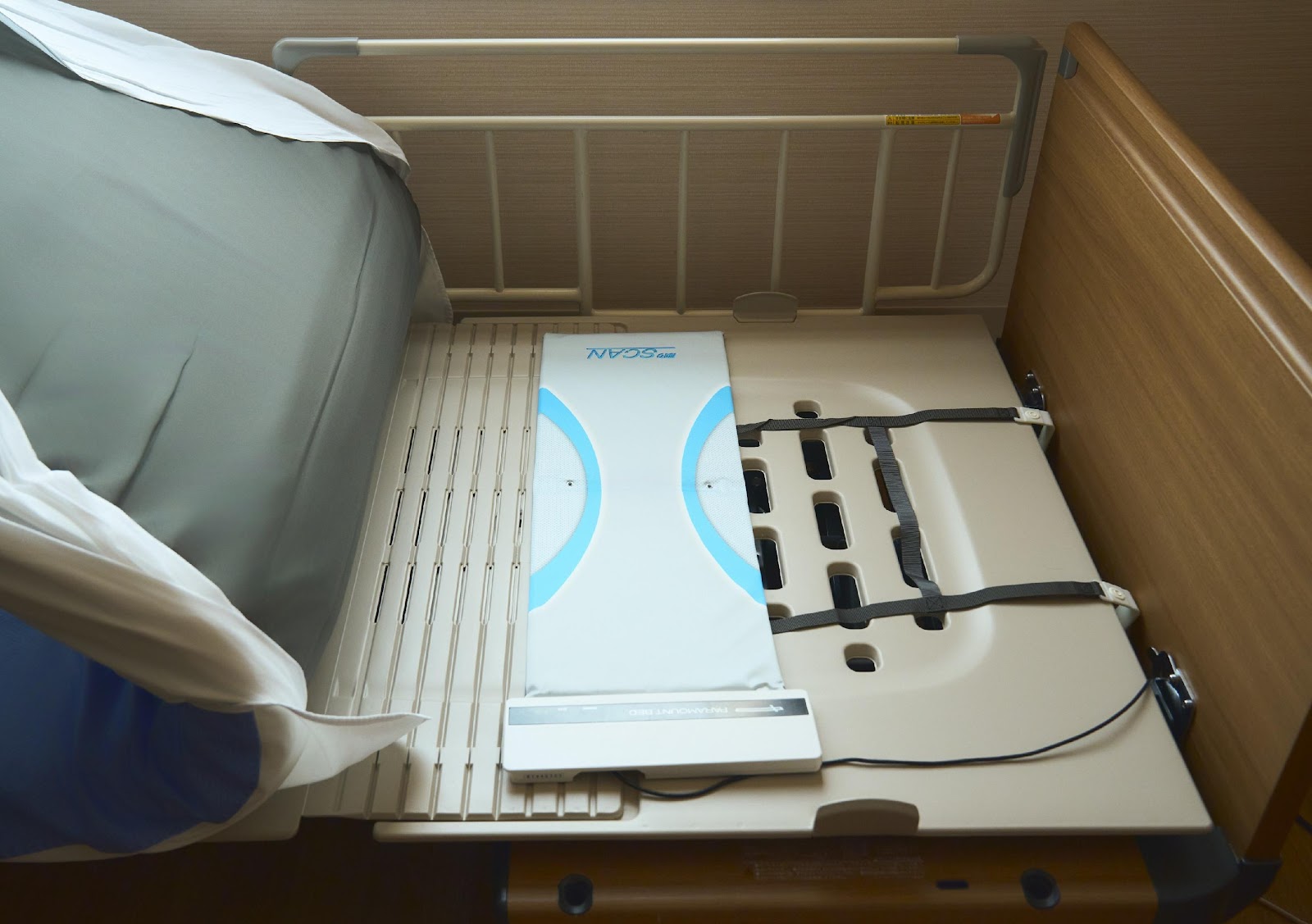
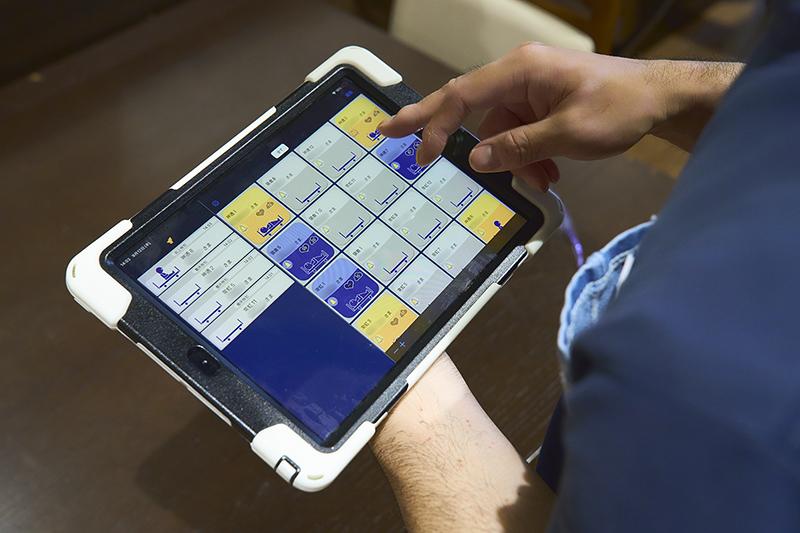
(Nemuri SCAN is installed under the mattress of the residents' beds. While in another room, a caregiver can check on residents to see if they are awake, getting up, or leaving the bed. The status of the resident, such as leaving the bed or falling asleep, is displayed in different colors, so the status can be seen at a glance.)
- I heard that you also use special software to create work shifts, which is often a problem for staff.
"We introduced work scheduling software in 2019. Previously, we adopted an analog approach in which each staff member submitted his or her preferred day off on paper, and the leader typed them into spreadsheet software to create and print out a work shift in line with the staff member's preferences. But the introduction of this software has greatly improved the efficiency of the process.
Now, when each staff member submits his or her preferred shift online, the software automatically creates a draft shift schedule that reflects their preferences and is based on detailed conditions, such as "No night shift with only new employees." Also, shift sharing is now online and has become smoother, and since work performance is recorded, linking it to payroll and labor management has also led to greater operational efficiency in the administration department."
- It seems that all the care workers wear intercoms. How are they being used?
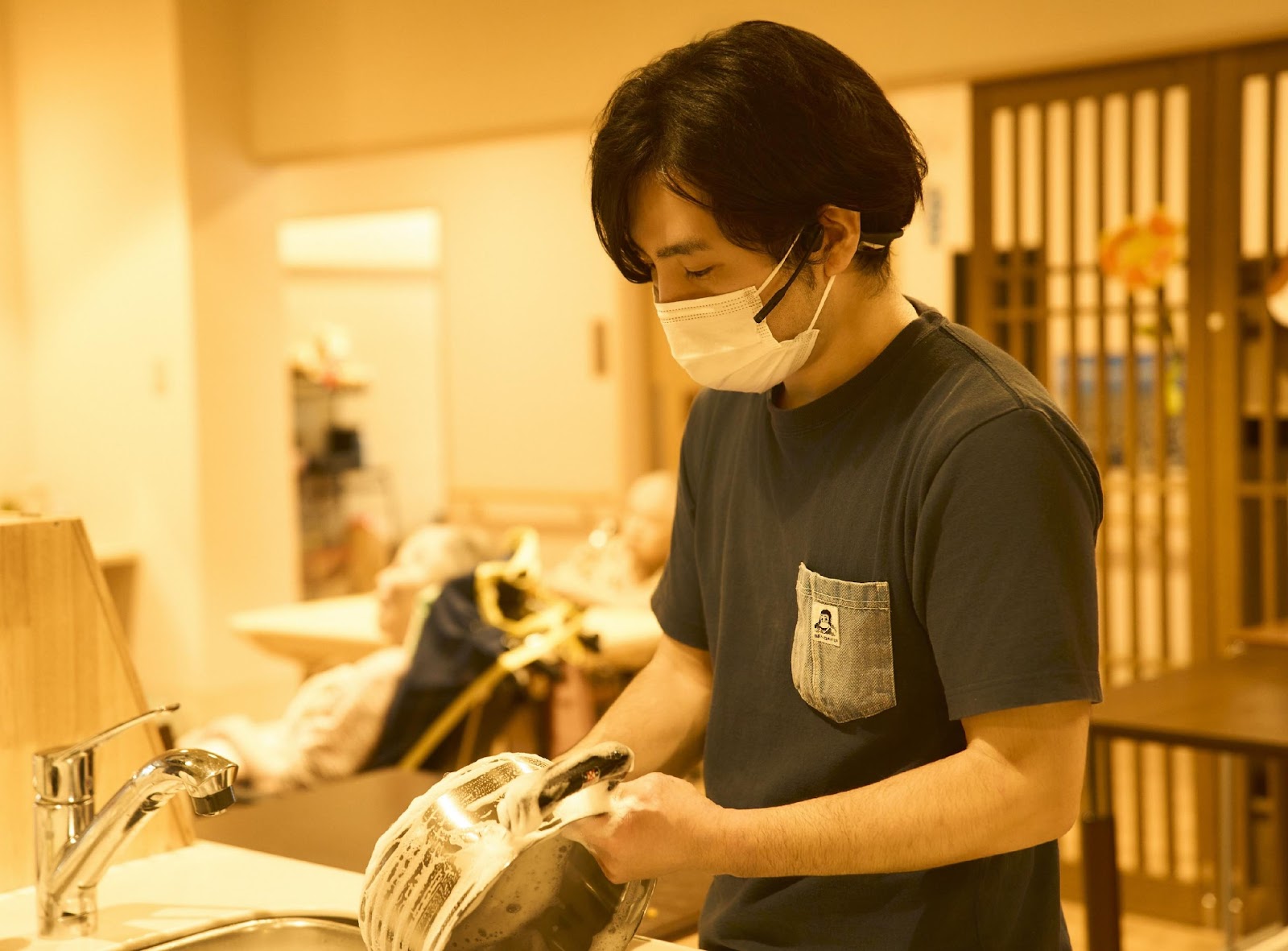
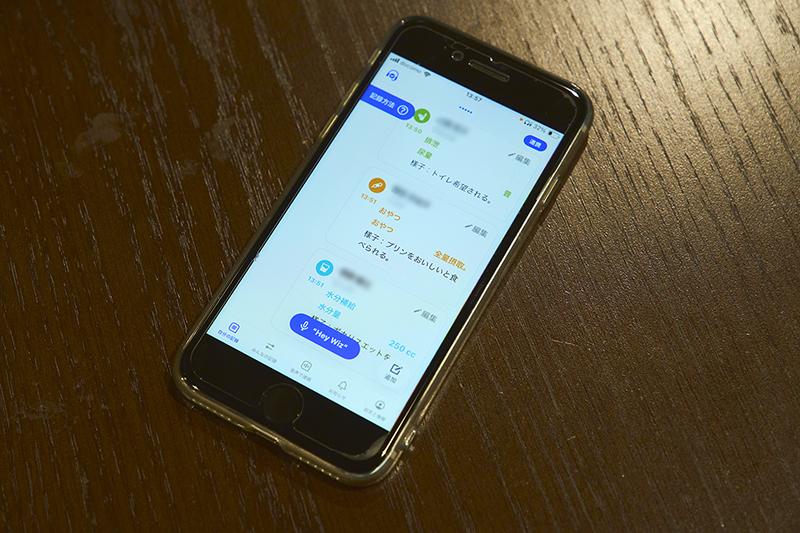
(The care workers wear bone conduction intercoms, so they can input nursing care records while doing other simple tasks, such as washing dishes.)
"We introduced transceiver-type intercoms in 2020 to share information among staff members in real time. Although they were effective in understanding the current conditions of staff members, the feedback from staff was that the wired earphones interfered with their work, so we have now switched to highly convenient bone conduction intercoms. In addition, the bone-conduction intercom, voice input system, and assistance software for nursing care services are linked together to realize remote input of nursing care records by voice.
Writing nursing care records is one of the tasks that requires significant amounts of time and effort for onsite staff members. They used to have to go to the office and sit in front of the computer to enter records. But now they can input records verbally by voice while doing simple tasks such as washing dishes or cleaning up, which has reduced the time to create records per day from 33 minutes to 17 minutes. In addition, in the two months after the introduction of the voice input system, the amount of information recorded doubled, from 6,713 to 13,162 characters, enabling more detailed recording. Also, it is significantly reducing the occurrence of recording omissions.
Furthermore, by utilizing the recording function of intercoms, the so-called "message transfer," which used to be done verbally at the time of shift changes, has been abolished, and operational efficiency has been improved."
- Please tell us about the costs up to the present time since you started full-scale digital transformation and ICT promotion in 2019.
"At Sasazu-en, we provide each of our approximately 100 regular employees with a PC or smartphone. Including these devices, we have invested an estimated budget of about 35 million yen over the four years since 2019. Fifty-six percent of this amount, or approximately 20 million yen, was funded by subsidies and grants from the Ministry of Health, Labour and Welfare, and from local governments."
Data acquisition and the establishment of a committee that satisfy the requirement for the Productivity Improvements Promotion System Addition
- The nursing care reimbursement system was revised in April 2024, and new reimbursement additions were established to promote efforts for productivity improvements. As the facility needs to meet multiple requirements, including "Introduce technology equipment", "Establish an ICT promotion steering committee", and "Submit data on the results of operational improvements", at first glance it seems too difficult. What measures have you taken to address this?
"Personally, I do not think it is that difficult. When we ask staff members onsite "What are the biggest problems you are facing right now?" and listen to their answers, and then we utilize ICT equipment and technology to resolve these problems, naturally productivity improves. We believe that obtaining results data is not that difficult either."
- One of the requirements is to "Establish a committee to ensure the safety of users and the quality of services, and to reduce the burden on staff." How does Sasazu-en operate such a committee?
"Sasazu-en established the ICT Promotion Committee in 2021, with the head of each division serving as a member. The Committee receives feedback and new proposals from onsite staff every month and exchanges opinions for the smoother use of ICT. As the number of ICT equipment items has increased recently, we have prepared a management system for attaching QR codes and changed the transportation system used at the day service center. So, I believe the Committee is functioning effectively."
- Are professional staff members with a strong interest in IT appointed to the Committee?
"No, actually that is not the case. The Committee members update their knowledge individually by searching on their own and asking IT vendor personnel to tell them about a technology. They seem to find it rewarding and enjoy that their suggestions are immediately realized and that they receive positive feedback from onsite staff members."
Productivity improvement efforts serve as
"state-of-the-art nursing care" branding, and also work to secure human resources
- What are the advantages of digital transformation and the use of ICT?
"Actually, we believe that it is likely to be advantageous when securing human resources, including recruiting and retention. Recently, we have been hiring new graduates every year, and when we ask them why they applied to us, many young people say they want to work in a facility equipped with state-of-the-art technology if they are going to provide the same level of nursing care. Sasazu-en is one of the few facilities that has obtained Productivity Improvements Promotion System Addition (I) in Toyama Prefecture. Thankfully, many staff members say that they want to work here even if their commuting time is a little longer."
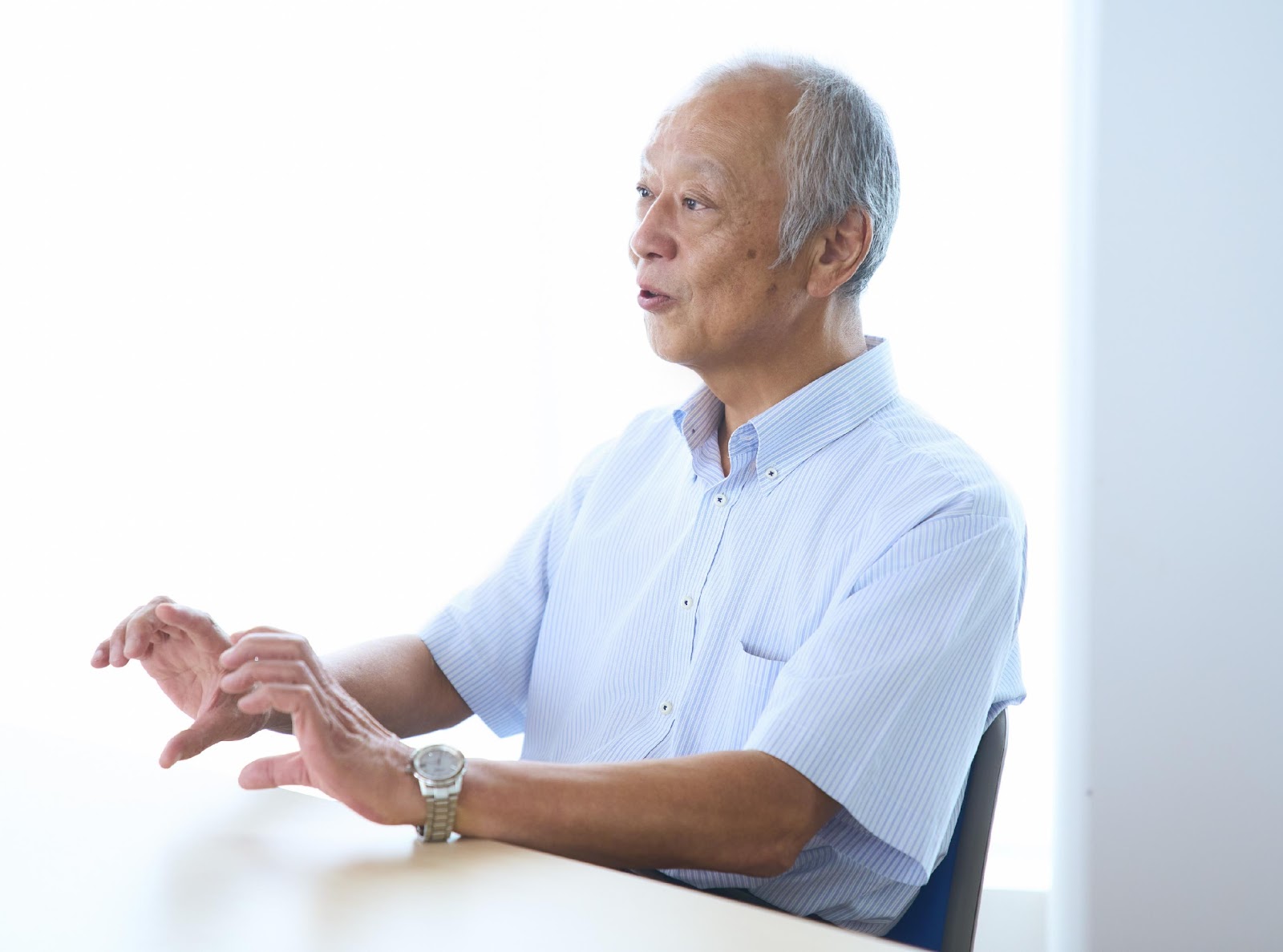
(Mr. Hiroyuki Iwai, the President of Sasazu-en)
- What do the staff members who have been working for the facility for a long time think about the digital transformation and ICT promotion?
"When we conducted a survey of existing staff members, 63% of them answered that their operations have improved. We believe that the digital transformation and the use of ICT will not be firmly established unless the staff members actually feel that it makes their operations easier and that it enables them to provide better services to the residents.
Some people may think that some staff members will be left behind in digital transformation. However, the voice input system of nursing care records I previously mentioned was strongly promoted by female staff in their 50s and 60s. For staff members who are not familiar with keyboard operation, voice input is extremely convenient, as what is spoken is recorded directly. When they saw a young staff member typing on a keyboard, they actively encouraged them to use voice input, saying, "Voice input is faster and easier.""
- So, tools that are easy to use for onsite staff are more likely to be accepted in the workplace.
"I think the staff members enjoy their work more in this way. We hope that the promotion of ICT will create a positive cycle by reducing the workload of operations other than nursing care that used to be a burden, enabling them to provide more detailed care to residents, and improving productivity by enabling staff to work on their own initiatives.
Sasazu-en's policy is "Do & Think." The order is important. Instead of "Think & Do," "Do" comes first. We encourage all staff members to try it first if they think something looks good, not just for the promotion of ICT. If we try it and it doesn't work, we just go back to the way it was before. Understanding individual ideas and putting them together to form a shape is the job of the onsite leaders and of us in the management team. If the results become a success story for the staff and help to increase their energy and motivation at work, we believe that this will lead to an improvement in the level of the entire corporation."
- What else have you done to improve staff productivity?。
"At Sasazu-en, we have employed care assistants for about 20 years to clarify the division of roles. This is an initiative from the time when the name "care assistant" had not yet even taken hold. By having care assistants take charge of cleaning, washing and changing bed sheets, we try to ensure that care workers are able to spend as much time as possible on their primary care work."
Long-term Care Technology and the use of ICT will contribute to improving the level of care
- How will the promotion of ICT, including digital transformation and Long-term Care Technology, change nursing care in the future?
"Currently, nursing care work has a craftsmanship aspect, so to speak, of being dependent on the experience and skills of staff. Some aspects of nursing care skills still remain dependent on the individual, leading to the shortage of human resources and differences in skill levels. Of course, as long as people do this work, there will be differences in skill levels, but we hope that the use of Long-term Care Technology and AI will enable everyone to receive a certain level of care and improve the level of nursing care, and I am optimistic that we will see such a society soon."
- Many young staff members are working at Sasazu-en, and it seems that a positive circle has been created in which the independence of staff is also being developed. Is the fact that the promotion of ICT promotion is working effectively related to this?
"I think that's right. In fact, I feel that the staff members at Sasazu-en are the most energetic. I myself and the staff members believe that there is still room to make nursing care more enjoyable and easier."
<End>
*1. Source: Japanese Council of Senior Citizens Welfare Service "Roushikyo Digital" (August 12, 2024)"